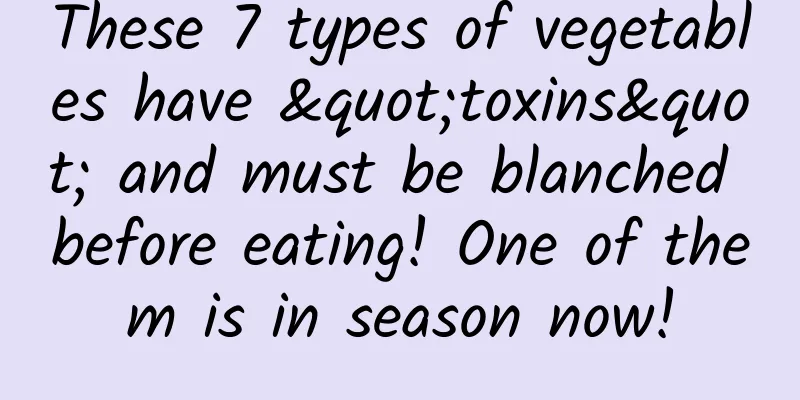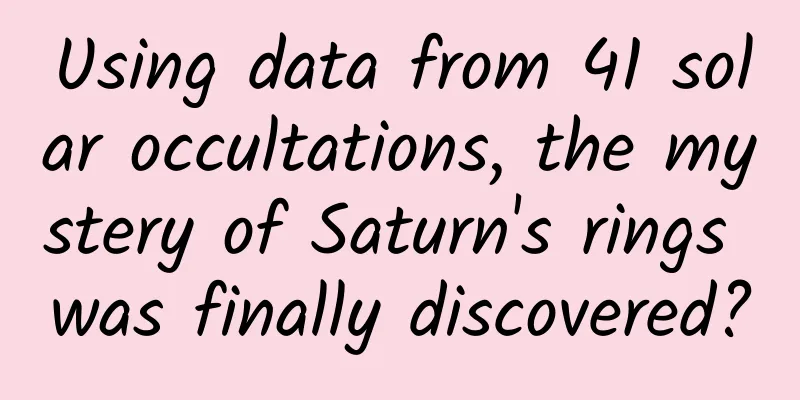These 7 types of vegetables have "toxins" and must be blanched before eating! One of them is in season now!

|
Blanching is one of the cooking methods we usually use at home. In daily life, most vegetables can be directly fried or stewed without blanching. However, some vegetables may naturally carry "dangerous elements" and it is best to blanch them before eating, otherwise it may bring danger! 01 Dangerous molecules in vegetables Oxalic acid: After being consumed by the human body, oxalic acid is easy to combine with calcium, iron and other mineral elements in the body , thus affecting the absorption and utilization rate of these mineral elements. For people with poor gastrointestinal function, it may also irritate the gastric mucosa and cause discomfort. Plant lectin: It is a macromolecular protein commonly found in the seeds and peels of plants. It is a self-defense of plants and can prevent animals from eating it. But it is also unfriendly to the human body. Eating too much plant lectin may cause nausea, vomiting, diarrhea and other poisoning. Nitrite: A small amount of nitrite is harmless to the human body, but excessive nitrite is toxic. Nitrite has a certain acute toxicity , and its median lethal dose for animals with caries is 57 mg/kg. Moreover, it increases the risk of cancer because nitrite reacts with protein decomposition products under acidic conditions to produce nitrosamines, which are recognized carcinogens. Copyright image, no permission to reprint Saponins: Saponins are highly irritating to the human digestive tract, can cause hemorrhagic inflammation, and have a lytic effect on red blood cells . If ingested in large quantities, saponins can irritate the gastrointestinal tract and cause vomiting and diarrhea. Cyanogenic glycosides: Cyanogenic glycosides are also a type of plant toxin, found in about 2,000 plant species. Cyanogenic glycosides themselves are not toxic, but when plant cells rupture, they are partially converted into hydrocyanic acid, which can cause poisoning in humans, leading to shortness of breath, decreased blood pressure, dizziness, headache, stomach pain, vomiting, diarrhea and other poisoning reactions, and in severe cases, may even lead to death. Colchicine: Colchicine itself is non-toxic, but after entering the human body, it is oxidized into dicolchicine oxide, which is toxic. Symptoms such as nausea, vomiting, abdominal pain, diarrhea, thirst, etc. may occur. In severe cases, there may be blood in the stool, hematuria or anuria. Pathogenic bacteria: Due to the special growing environment, some vegetables may be easily contaminated by pathogenic bacteria, the most common of which are Listeria, Salmonella and Escherichia coli. Among them, Salmonella and E. coli mainly cause vomiting, diarrhea, fever and other symptoms; Listeria monocytogenes can harm the health of infants, the weak, the elderly and other people with low immunity. After infection with Listeria monocytogenes, symptoms such as fever, headache, nausea, abdominal pain, etc. Pregnant women may also suffer miscarriage or even fetal death after infection. 02 Recommended Blanching Vegetables 1) Vegetables containing lectins: Legume vegetables contain relatively more lectins, such as green beans, cowpeas, red kidney beans , etc. Plant lectins are not heat-resistant, and their structure can be destroyed by thorough heating. These legumes usually need to be heated at 100°C for more than 10 minutes to ensure safety. If they are not heated thoroughly, the toxins will remain and easily lead to food poisoning. 2) Containing colchicine: Daylily Fresh daylily contains colchicine and cannot be eaten directly. Colchicine is water-soluble, so fresh daylily must be processed to remove colchicine before consumption. If you want to eat fresh daylily, remove the stamens before eating, blanch it, and then soak it in cold water for more than 1 hour to reduce its toxicity. Copyright image, no permission to reprint 3) Containing nitrite: Toon Although the nitrite content in most Chinese toon (especially fresh Chinese toon) is generally not high and will not cause any harm, the nitrite content in some Chinese toon can sometimes reach the level of 1,000 milligrams per kilogram. If you accidentally eat too much, you may get poisoned. There have been cases of nitrite poisoning caused by accidentally eating Chinese toon in the past. The good news is that before eating Chinese toon, you can remove most of the nitrite by blanching it with hot water. For example, studies have shown that when blanching Chinese toon, about 80% of the nitrite can be removed in 30 seconds, and 83.86% of the nitrite can be removed in 45 seconds. Therefore, when eating Chinese toon, you must blanch it in boiling water first, and blanch it for 30-40 seconds. 4) Vegetables rich in oxalic acid: Bitter vegetables such as spinach, purslane, wild rice stem, and bamboo shoots Vegetables with high oxalic acid content usually taste astringent and not very tasty. However, oxalic acid is soluble in water, so it is best to blanch these vegetables in water before eating to get rid of the oxalic acid problem. Generally speaking, leafy vegetables such as spinach and purslane only need to be blanched for 15-20 seconds after the water boils, and the leaves will become darker in color and can be picked up. Root vegetables such as wild rice stems and bamboo shoots can be blanched for 3-5 minutes. If you use these vegetables to make soup, you can blanch them separately first and then add the vegetables to the soup when the soup is almost cooked. This way, there will not be too much oxalic acid in the soup. Copyright image, no permission to reprint 5) Bean sprouts Bean sprouts have a sweet and refreshing taste, and many families make them at home. However, bean sprouts are easily contaminated by microorganisms. The World Health Organization's assessment report on bean sprouts and other sprouts shows that there may be a risk of pathogenic bacteria contamination in sprouts. Because the environment in which bean sprouts grow - a humid and warm place - is also suitable for the growth and reproduction of microorganisms, the chance of bean sprouts being contaminated by pathogenic bacteria is very high, and the more common ones are Listeria, Salmonella and E. coli. According to statistics from the U.S. Food and Drug Administration (FDA), between 1996 and August 2020, there were 52 foodborne illness outbreaks associated with contaminated bean sprouts, infecting 2,700 people. These pathogenic bacteria are afraid of heat, and blanching them in hot water can kill them and ensure safety. The FDA has also repeatedly emphasized that all kinds of bean sprouts, including mung bean sprouts, must be fully heated before they can be safely eaten! Therefore, when eating bean sprouts, especially cold bean sprouts, they must be blanched in hot water before eating. 6) Vegetables containing cyanogenic glycosides: Cassava, ginkgo and bitter apricot, etc. Cassava, ginkgo and bitter almonds are foods that contain a lot of cyanogenic glycosides. Cyanogenic glycosides are soluble in water and can be destroyed by heating. Therefore, they can be eaten after removing the seed coat and germ, soaking and blanching them until they are cooked thoroughly. 7) Vegetables that are difficult to clean: Broccoli, cauliflower, black fungus, bean curd sticks, kelp, etc. Flower-shaped vegetables, such as cauliflower, have a layer of wax on the surface that water cannot effectively contact. In addition, it has many flower spikes, so when washing, the water will form a ball and slide off the surface of the broccoli as soon as it touches the surface. Considering its dense structure, many friends are worried that the dust, pesticide residues, insect eggs and other pollutants in the broccoli cannot be washed away. At this time, blanching it in hot water will not be a big problem. In addition, cauliflower, fungus, bean curd, kelp, etc. may not be easy to clean due to their structure, so they can be blanched in water. 03 When blanching Should I put the pot in cold water or hot water? In fact, whether to put the food in cold water or hot water is not the key point. The core of the problem lies in the temperature and blanching time. For leafy vegetables such as spinach and rapeseed, it is usually sufficient to blanch them in boiling water for 15 to 20 seconds. Root vegetables such as bamboo shoots, potatoes, yam, and radish can be blanched for a few minutes longer, while beans such as green beans need to be blanched in boiling water for more than 10 minutes. Copyright image, no permission to reprint 04 When blanching vegetables Will the nutrients be lost? When vegetables, especially green leafy vegetables, are blanched, some water-soluble vitamins and minerals, such as vitamin C, vitamin B1, vitamin B2, calcium, phosphorus, potassium, etc., may be lost. Moreover, this loss is not devastating, and most of them are actually retained. For example, data shows that the retention rates of calcium, phosphorus and potassium in common root vegetables, fresh beans, potatoes and nightshade vegetables are mostly between 60% and 80% after stir-frying, frying or blanching; blanching will cause a loss of about 50% of vitamin B1 and vitamin B2 for both root vegetables and leafy vegetables. However, these losses are still at an acceptable level for people and are not as much as everyone imagines. Moreover, compared with other cooking methods such as stewing, stir-frying and frying, blanching will not cause much more loss. Considering that these vegetables can better ensure our health after blanching, overall, the benefits outweigh the disadvantages, so there is no need to worry too much. References: [1]https://www.fao.org/food-safety/news/news-details/en/c/1629712/ [2]https://www.who.int/zh/news-room/fact-sheets/detail/natural-toxins-in-food [3]https://www.cfs.gov.hk/tc_chi/programme/programme_rafs/programme_rafs_fc_01_17_report.html [4]https://www.food-safety.com/articles/7743-fda-issues-final-guidance-on-seeds-for-sprouts [5] Zhao Hongjing, Yang Xiaoli, Zhou Ruihua, et al. Study on retention factors of vitamin B1 and vitamin B2 in vegetables [J]. Journal of Health Research, 2008, 37(1):92-96. DOI:10.3969/j.issn.1000-8020.2008.01.029. Zhao Hongjing, Yang Yuexin. Study on retention factors of vitamin C in vegetables [J]. Journal of Chinese Institute of Food Science and Technology, 2007, 7(1):30-35. DOI:10.3969/j.issn.1009-7848.2007.01.006. [6] Zhao Hongjing. Study on weight and nutrient retention rate of vegetables during cooking[D]. Beijing: Chinese Center for Disease Control and Prevention, 2004. [7] Pan Xingchang, Zhao Hongjing, Men Jianhua, et al. Study on the cooking retention factors of calcium, phosphorus, potassium and sodium in vegetables [J]. Journal of Nutrition, 2007, 29(1): 43-45. DOI: 10.3321/j.issn:0512-7955.2007.01.012. Author: Ruan Guangfeng, Director of the Science and Technology Department of the Kexin Food and Nutrition Information Exchange Center Reviewer: Gao Chao, Associate Researcher, Institute of Nutrition and Health, Chinese Center for Disease Control and Prevention The cover image and the images in this article are from the copyright library Reproduction of image content is not authorized |
>>: Do you often misremember things? Your memory may be playing tricks on you
Recommend
Tesla lost money in 15 years, while NIO lost all its money in 4 years. Traditional car manufacturers are still reliable in making cars.
Recently, along with the exposure of the extravag...
Microsoft: 49% of respondents in the 2023 Job Trends Index report are worried about being "taken away" by AI
Microsoft recently launched its 2023 annual Work ...
Will the second wave of infection peak in March-May? Two groups of people may be most affected!
During the Spring Festival that just passed, ther...
From Alibaba and Tencent to Xiaomi and Huawei, let's look at the giants that have been cheated by TV games
Everyone says that the gaming industry is very pr...
Manufacturers are flocking to AI mobile phone chips, and what they value is the value behind it.
In the past two years, artificial intelligence te...
How should operations put forward requirements for products to accurately hit the key points?
As an operator , it is inevitable to make demands...
2K screen HTC One M9 concept image exposed with extremely narrow bezel
Although it is rumored that HTC's next-genera...
The EU plans to promote universal mobile phone chargers. Will Apple and Android charging interfaces be unified?
According to foreign media reports, despite Apple...
"Goodbye Love 4" is a big hit, attracting analysis from the entire network! Does she really have "borderline personality disorder"?
In the recent hit variety show "Goodbye Love...
How to do live streaming sales from 0 to 1
In 2016, live streaming e-commerce entered the pu...
Brand marketing promotion: Why does Haidilao never advertise?
As a leader in the catering industry, Haidilao is...
How to effectively activate new users?
Attracting new users does not mean activating new...
Jiang Yulong (Fenglinyang) Prince Quantitative Theory and Practice Teaching Base No. 20
Jiang Yulong (Fenglinyang) Prince Quantitative The...
[Daiyu Finance] Yan Fan Tactics Yan Style Tactics First Style Tutorial - Heaven and Earth are missing and holding a golden baby
[Daiyu Finance] Yan Fan Tactics Yan Style Tactics...
An event planning and execution plan!
There are many steps from planning to completion ...









